| Pages:
1
..
7
8
9
10 |
aga
Forum Drunkard
    
Posts: 7030
Registered: 25-3-2014
Member Is Offline
|
|
If you make your own bread you can add or remove whatever you like.
Best to keep the yeast, flour and water.
I had a hunch that Sulphur would be good, so tried it.
Tuned out to be less than good.
Unlikely anyone will find an unsliced 10% sulphur bread in any shop.
|
|
|
DrP
National Hazard
   
Posts: 625
Registered: 28-9-2005
Member Is Offline
Mood: exothermic
|
|
Is that because it vulcanises rubber?
If you or anyone else wants to try some APP then PM me your address and I'll send some with a SDS. It is pretty safe and inert. As I said - APP is the
industry standard charring aid for carbon based polymers.
I don't have the time or facility to bake bread. Maybe soaking it in an APP solution would help, but I think the phase II material would be better
from experience. The Phase I soluble stuff is good at stopping flaming, but the Phase II stuff (higher molecular weight) is much better for
crosslinking in chars. Maybe mixing into the dough before baking would give the most homogenous distribution of it.
\"It\'s a man\'s obligation to stick his boneration in a women\'s separation; this sort of penetration will increase the population of the younger
generation\" - Eric Cartman
|
|
|
DrP
National Hazard
   
Posts: 625
Registered: 28-9-2005
Member Is Offline
Mood: exothermic
|
|
Quote: Originally posted by Chemetix  | | I don't have the time to go and try this so don't crucify me. But has anyone tried, or would like to try, dipping their bread refractory foam in a
thin mix of plaster and see what happens. Or sodium silicate perhaps, just something to shield the carbon from getting oxidised.
|
Why would anyone crucify you? Surely all wisdom is welcome, no? Only a total twat would shun your experience and knowledge that you are generously
sharing for free here - especially as this is a discussion forum. (have you ever seen a child with play bricks trying to build a wall in multiple
columns of bricks rather than overlapping them?.. some kids would welcome being told that overlapping gives a stronger wall.... some just get grumpy
and bratty and throw the bricks at you and tell you to do it yourself, lol, I guess it depends on upbringing or something)
I think they tried enclosing the bread off from O2... I do have Nitrogen and would like to try what they have done over nitrogen or some other inert
gas but wont get time either. Maybe I could slip something into the furnace at work while other test are going, lol, but I don't want to mess about
here really.
I still think APP is the thing to try. A little blowing agent might make the bread rise more also into a larger more porous foam.
[Edited on 20-2-2018 by DrP]
\"It\'s a man\'s obligation to stick his boneration in a women\'s separation; this sort of penetration will increase the population of the younger
generation\" - Eric Cartman
|
|
|
RawWork
Hazard to Others
  
Posts: 167
Registered: 10-2-2018
Member Is Offline
|
|
Expecting porous stuff like bread to have good electrical conductivity does not make sense. The more porous something is, the less conductive it is.
Especially carbon which even solid is weak conductor. The only useful stuff i see here is thermal insolator. But only if it's easier to make then any
other thermal insolator. I mean the purpose of bread is to be porous, so we already know what properties to expect. Using it as crucible sounds
impossible. Try holding water in sponge 
|
|
|
Fulmen
International Hazard
    
Posts: 1693
Registered: 24-9-2005
Member Is Offline
Mood: Bored
|
|
Forgive me if it's been covered, but I couldn't find anything about it. Has anyone tested it's resistance to oxidation at prolonged heat? I'm
considering building a furnace, and if it can withstand prolonged heat without a complete absence of air it could be an interesting choice. It
wouldn't be directly exposed to the heat of course, I'm imagining it covered with fire clay or high-temp cement.
We're not banging rocks together here. We know how to put a man back together.
|
|
|
DrP
National Hazard
   
Posts: 625
Registered: 28-9-2005
Member Is Offline
Mood: exothermic
|
|
Being fair - they started measuring conductivity and commenting on it as a side discussion due to their observations. The thread is about making a
refractory foam. The more porous the foam the better thermal insulation it should have.
\"It\'s a man\'s obligation to stick his boneration in a women\'s separation; this sort of penetration will increase the population of the younger
generation\" - Eric Cartman
|
|
|
RawWork
Hazard to Others
  
Posts: 167
Registered: 10-2-2018
Member Is Offline
|
|
I noticed few posts about best possible electrode in world... Also gases are better insolator.
|
|
|
DrP
National Hazard
   
Posts: 625
Registered: 28-9-2005
Member Is Offline
Mood: exothermic
|
|
Thermally too - thus the desire for increased porosity in the foam.
\"It\'s a man\'s obligation to stick his boneration in a women\'s separation; this sort of penetration will increase the population of the younger
generation\" - Eric Cartman
|
|
|
happyfooddance
National Hazard
   
Posts: 530
Registered: 9-11-2017
Location: Los Angeles, Ca.
Member Is Offline
Mood: No Mood
|
|
This might be worth mentioning:
Panko (japanese bread crumbs) are made by cooking bread with an electric current rather than in an oven. The bread is consistent from end to end, and
makes crumbs whose grains are uniform, unlike a normal loaf, which has variable consistency.
|
|
|
aga
Forum Drunkard
    
Posts: 7030
Registered: 25-3-2014
Member Is Offline
|
|
Now that is worth mentioning !
Cheers. Will look at how Panko is done
Edit:
A bit of research says that Japanese soldiers in WWII invented a method to make bread using electric current. Most likely a car battery. Will give
that a try.
The gluten probably gets elongated more due to the 3x 'rising' cycles. We'll see.
Bought a new Pyrolysis Rig today for 20 euros :
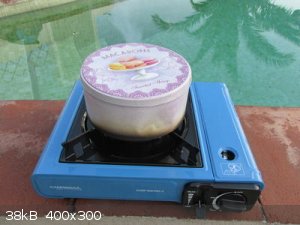
[Edited on 20-2-2018 by aga]
|
|
|
SWIM
National Hazard
   
Posts: 970
Registered: 3-9-2017
Member Is Offline
|
|
Quote: Originally posted by Chemetix  | | I don't have the time to go and try this so don't crucify me. But has anyone tried, or would like to try, dipping their bread refractory foam in a
thin mix of plaster and see what happens. Or sodium silicate perhaps, just something to shield the carbon from getting oxidised.
|
GET THE NAILS!!
Seriously, I'd wondered about firing it in molten potassium carbonate for similar reasons.
Might just come apart in the boiling liquid if not tough enough, but if it ever gets cold around here again I've got crude carbonate that needs firing
anyway and will give it a go. (assuming I can make bread sink in molten potassium carbonate, might need a 'cement overcoat', or at least some
ballast.)
However I am surprised nobody has introduced Marmite into the equation. Not that I expect it would do any good, but it's probably a better use for the
stuff than actually eating it.
|
|
|
aga
Forum Drunkard
    
Posts: 7030
Registered: 25-3-2014
Member Is Offline
|
|
Thinking about it a bit more, Chemetix's idea allows other possibilities.
If the bread is encased in a plaster 'skin' with a hole at one end, then the breakdown products will have to pass through the rest of the material as
it pyrolyses, possibly reacting as it does so.
Adding a blob of something (at the opposite end to where the gas-escape hole will be) before dipping it all in plaster would cause it's vapours to
also pass through the hot material in this process.
Hmm. Sounding promising.
|
|
|
aga
Forum Drunkard
    
Posts: 7030
Registered: 25-3-2014
Member Is Offline
|
|
Quote: Originally posted by Fulmen  | | Forgive me if it's been covered, but I couldn't find anything about it. Has anyone tested it's resistance to oxidation at prolonged heat?
|
If you call 2 minutes 'prolonged' then yes, just now, due to your question.
This slice of rye bread didn't come out too well with the new pyrolyser - it isn't conductive.
Here it is raw, subjected to 2 minutes under a 70% Butane/30% Propane flame, then the other side was subjected to 2 mins under a MAPP gas flame.
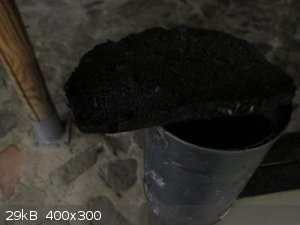
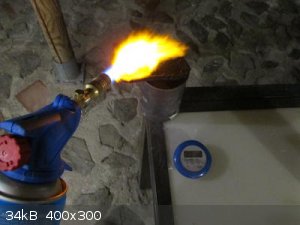
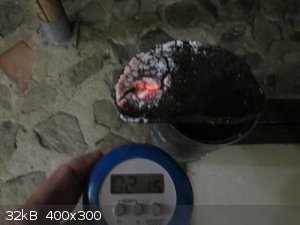
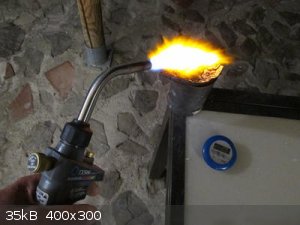
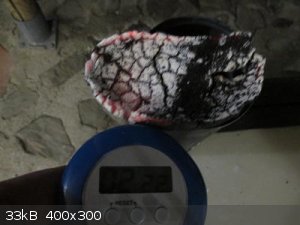
This particular sample was a bit iffy to begin with, yet shows how durable it is under heat, even in air.
After this test the toast fell apart when it was picked up. Big chunks, but definitely in bits.
|
|
|
Fulmen
International Hazard
    
Posts: 1693
Registered: 24-9-2005
Member Is Offline
Mood: Bored
|
|
Not exactly what I was thinking of, but thank you very much for the experiment. I'm guessing it's heat resistance depends on the charring temperature,
guess I'll have to do some experiments once my grill emerges from the snow. Can't use the furnace as it would stink up the basement too much, but
perhaps it would be OK after the initial charring?
We're not banging rocks together here. We know how to put a man back together.
|
|
|
aga
Forum Drunkard
    
Posts: 7030
Registered: 25-3-2014
Member Is Offline
|
|
Pyrolysing it well, i.e. to completion seems to be the key.
If the bread is not reduced to 100% carbon it will burn normally.
That sample in the photos i would guess was 90% 'done' before it met the flames.
(new fire thing isn't quite as good as a wood fire)
Some parts did burn with a flame, briefly, during the butane/propane burn.
Edit:
If this MAPP gas works as advertised, the flame temperature is over 2,900 C.
The half-baked pyrolysed bread at least held it's shape, which is amazing.
[Edited on 20-2-2018 by aga]
|
|
|
Fulmen
International Hazard
    
Posts: 1693
Registered: 24-9-2005
Member Is Offline
Mood: Bored
|
|
MAPP/air has an adiabatic flame temperature of 2000°C, in reality it will be far lower.
I suspect this is comparable to cooking charcoal. There carbon content ranges from around 50% at 300°C to more than 90% at 1000°C.
We're not banging rocks together here. We know how to put a man back together.
|
|
|
aga
Forum Drunkard
    
Posts: 7030
Registered: 25-3-2014
Member Is Offline
|
|
For anyone interested in using this bread/carbon stuff structurally, the average shrinkage during pyrolisation came out at 27% today.
3 chunks of home made bread were measured, pyrollised in a charcoal fire, then re-measured.
Again the resistance is quite low this time measuring 11.7 ohms in a point-to-point test.
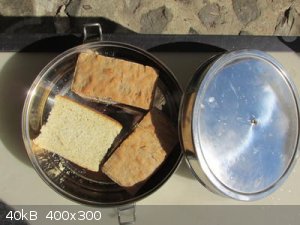
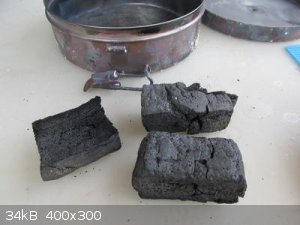
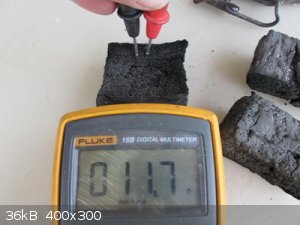
Here's the supporting data for the shrinkage figure.
Attachment: data.ods (13kB)
This file has been downloaded 338 times
|
|
|
violet sin
International Hazard
    
Posts: 1475
Registered: 2-9-2012
Location: Daydreaming of uraninite...
Member Is Offline
Mood: Good
|
|
Latest attempt
- the bake my own bread option went out the window with roof repairs and family time. But bbq dinner offered a shoot from the hip opportunity. These
are seed pods from a tree in my yard, a sweet gum.
Pre incineration,
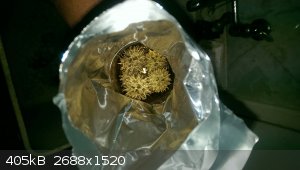 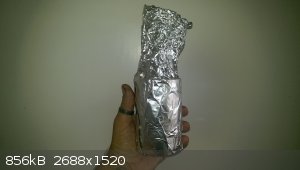
Post roast
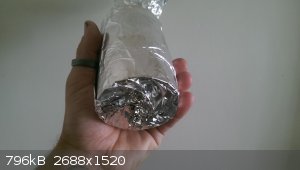 
 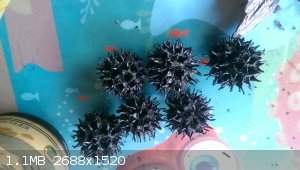
I have a feeling that there may be more loss on further torment. The aluminum foil was as shiny as ever, and the cans label was faint though legible.
But they are crispy/brittle. My plan to invest as little time as possible succeeded, family didn't miss me for long. Just closed the bbq vent 95%
and walked away.
Every experiment leads to a wealth of ideas for next time on this one for me. Gratifying, cheap, full of room for insane detail if the free time
arises.
Drive to work offers thinking time. Takeaway this morning : seed pods can retain geometry... Things like dry cereal such as Kix or cocopuffs could
be great preforms... Rice crispy treats are moldable... Rice itself is fairly consistent... We can have compact or foamy preforms to use as
ingredients.
,
So adulterated rice crispy treats and a crap-ton of sample compositions will eventually have to be tested.
|
|
|
aga
Forum Drunkard
    
Posts: 7030
Registered: 25-3-2014
Member Is Offline
|
|
Cool !
They look really interesting. Also looks like they didn't shrink much.
|
|
|
violet sin
International Hazard
    
Posts: 1475
Registered: 2-9-2012
Location: Daydreaming of uraninite...
Member Is Offline
Mood: Good
|
|
Tried a second firing on the sweet gum balls, not measured first time. One trial of two balls lost 5.26% more on second firing. Not a tremendous
amount and the shape/size distortion was minimal. Though I did not get a caliper on them during any of this.
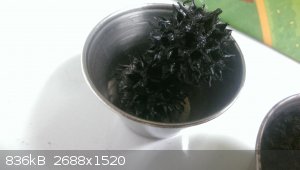 ^ v ^ v 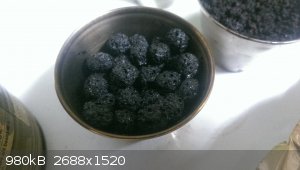
Some lightly frosted puff like cereal. Turns out the coating makes a decent binder after ignition. They lost ~44%
Grapenuts cereal lost ~24% after two trips through the BBQ. First time they were only a deep burgundy / brown. Now a good black.
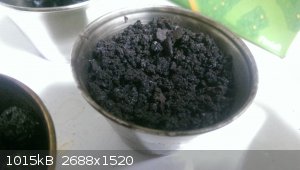 ^ v ^ v 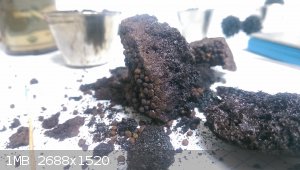
A little disappointing was a test on tapioca pearls... It did not cook evenly, the one side was exactly like a muffin pouring out. But the interior
of that area was well detailed and airy. The pearls did not simply char with my limited heat control. It lost ~21.4%
Then there was a wild shot in the dark mix of wheat gluten, potato starch, Styrofoam balls and a wildly impulsive dab of numerous additives that will
give little clue to their individual effectiveness... Below 1-3 , white lithium grease spray and graphite powder worked as a release.
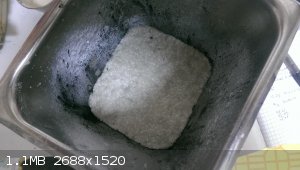 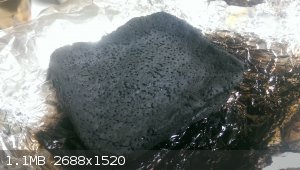
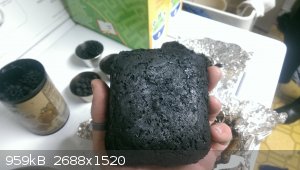 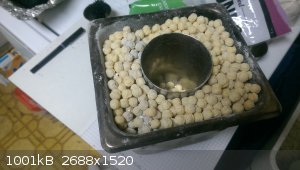
Last from above ^ this idea was Last on and did not receive enough heat to be blackened the whole way, but tomorrow is another day. It's a
stainless steam tray insert with a stainless cup set inside, the interspace filled with cereal. I foiled over the top and flip it foil side down on
the grill. If all goes well, I'll have a nice foamy crucible shape. I mixed a little confectioners sugar and wheat gluten in as these were not
frosted. My son was horrified when I showed him what used to be ~25g of his puffs... Had to be reassured I wasn't going to ruin them all.
We're that to succeed one could try a second coating or brush on paste for a more closed pore look. My better half got me a couple jumbo size boxes
of puff cereal... Keeps me out of her kitchen, lol. Plenty of material to play with for a while now.
None of this has been really high heat and no resistance tests were performed. Just weight pre/post BBQ roasting.
|
|
|
aga
Forum Drunkard
    
Posts: 7030
Registered: 25-3-2014
Member Is Offline
|
|
Superb experimentation violet sin !
You're in lead regarding the number of different items shoved in a fire, also actual Data regarding weight change.
Definitely need the resistance measuring - you might have discovered something awesome already 
|
|
|
violet sin
International Hazard
    
Posts: 1475
Registered: 2-9-2012
Location: Daydreaming of uraninite...
Member Is Offline
Mood: Good
|
|
Ok so the preform did not work... It easily could work, but this time was no. The whole top portion was stuck in one chunk (nicely), further down
was not so. The gluten/sugar mix was not evenly spread despite misting the cereal and folding the powder in. When the cup came out, part of the
lower char came dislodged and fell in the recess.
Frosted cereal would be far more convenient or just some kind of rice crispy treat like mixture. The forms are nice and so far seem well suited to my
goal.
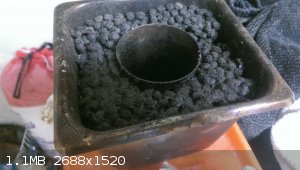 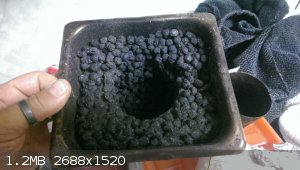 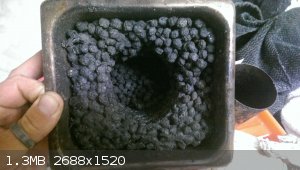
So after all this playing around with carbon char foam, and a wide field of possibilities, I narrowed down to one goal. At least first off. I want
to play with high temp fun, I don't want to buy ceramic fiber blanket for the prices I've seen... So refactory foamy insulation it is. For a quick
and dirty project to test these materials, I wanted to do something like a heating mantle-ish set up.
I know it's more professional to come to the table with a finished product before revealing your plans.. but I literally don't care if I fail here,
in fact I'm sure I will, many times at the very least. Lol.
Basic plan is to cast a rough shape as seen above. True up the sides, trim and shape the thing. Then either paint it or wrap and refire it and then
paint it with ceramic or plaster etc. Install a through way for wires and standoffs for the element.
I could easily see a small mantle for my 14/20 set taking shape with enough effort. But really the possibilities are immense. Electrodes, catalyst
support, insulation... It's wide open. Best to pick one and optimise.
|
|
|
aga
Forum Drunkard
    
Posts: 7030
Registered: 25-3-2014
Member Is Offline
|
|
Looking good there violet
|
|
|
violet sin
International Hazard
    
Posts: 1475
Registered: 2-9-2012
Location: Daydreaming of uraninite...
Member Is Offline
Mood: Good
|
|
Newest test run, same steamer insert form and ss cup center form.
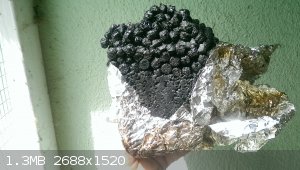 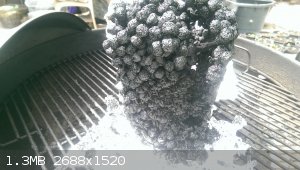
-(Pic 1): New kind of frosted puff cereal cap and rice crispy (w/ starch/sugar binder) side shot
-(Pic 2): consequence of over fill was cooking on side = separation rift largely empty.
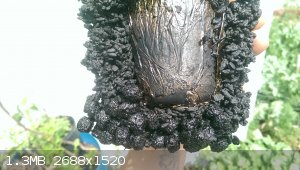 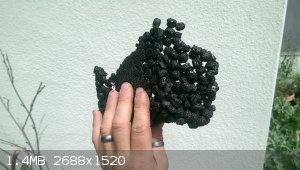
-(Pic 3): Side shot of strata. Was surprisingly TENACIOUS grip on the center form cup,
-(Pic 4): frosted chunks, sans adulterants, really hold shape with minimal contact.
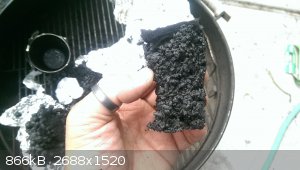 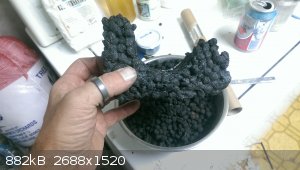
-(Pic 5): rice crispy preform from center cup, shrunk a lot, but I did add a fair amount of water to make moldable consistency.
-(Pic 6): removed chunk of last experiment.
That of course was not the sum total of objects toasted, but last time it dumped the typed words and loaded pics, assuming too much. A couple things
need be further toasted.
There was a flat one with paper towel and sugar with cotton face wipes = deformed easily and cracked.
There was a ovoid shape, 2 small stainless bowls stacked face to face. But the al foil/ss bowls/al foil was a pretty effective heat shield on top of
being a good form. It awaits further charting.
Bought more of the overly frosted puffs, I will be toasting them as is later today as well as trying some surface cover mixtures on the previously
toasted and failed chunks. Need an atmosphere resistant cover for actual future use to move forward.
This chosen cereal may be a cheap as-is usable material here. It's almost a bit glassy when done, 48% sugar content lol. 2.49$ for a huge bag. This
time Will be parchment paper-- aluminum foil-- parchment paper-- char material. I'm just gonna make a block form sans SS pan. I feel that it
greatly adds to the cook time. First light was 1:30am, final check was at 5am with more charcoal added @ 3:15am while turning. HOURS in the bbq and
yet not complete carbonization. Darn it.
Choice of parchment paper as effective release b/c of excruciating effort to place pieces that didn't char in that place was caused by pinhole in al
foil leading it to stick to as bowl. Poor adhesion from poor charing plus sticking = F*$# me running.
No weights were taken b/c family time conflicting with hobby & family > play time  hopefully mor pics and progress this evening. hopefully mor pics and progress this evening.
|
|
|
mayko
International Hazard
    
Posts: 1218
Registered: 17-1-2013
Location: Carrboro, NC
Member Is Offline
Mood: anomalous (Euclid class)
|
|
Quote: Originally posted by mayko  |
Someone brought some nasty BlunderBread hamburger buns to my 4th of July cookout and they've been sitting in the fridge since. Finally, a use for
them!
|
These sat in my freezer until last week. They were dehydrated when I pulled them out. I wrapped each of four in Al foil and stacked them in a steel
can, which was then half-buried in a charcoal fire.
Once cool and unwrapped, I found tough, surprisingly strong carbon foam slices. They were much lighter, from ~60% to ~25% of the starting mass of
~34.4g. The bottommost foam was not only the lightest, but the only one for which I could find a detectable (ie, finite) resistance.
| Code: |
mass (g) resistance (Ohm/cm)
Top 20.41 -
13.59 -
10.36 -
Bottom 8.22 35k
|
I can think of at least two possible explanations: heat gradient (hotter at the bottom) and redox gradient (more O2 at the top)
al-khemie is not a terrorist organization
"Chemicals, chemicals... I need chemicals!" - George Hayduke
"Wubbalubba dub-dub!" - Rick Sanchez
|
|
|
| Pages:
1
..
7
8
9
10 |